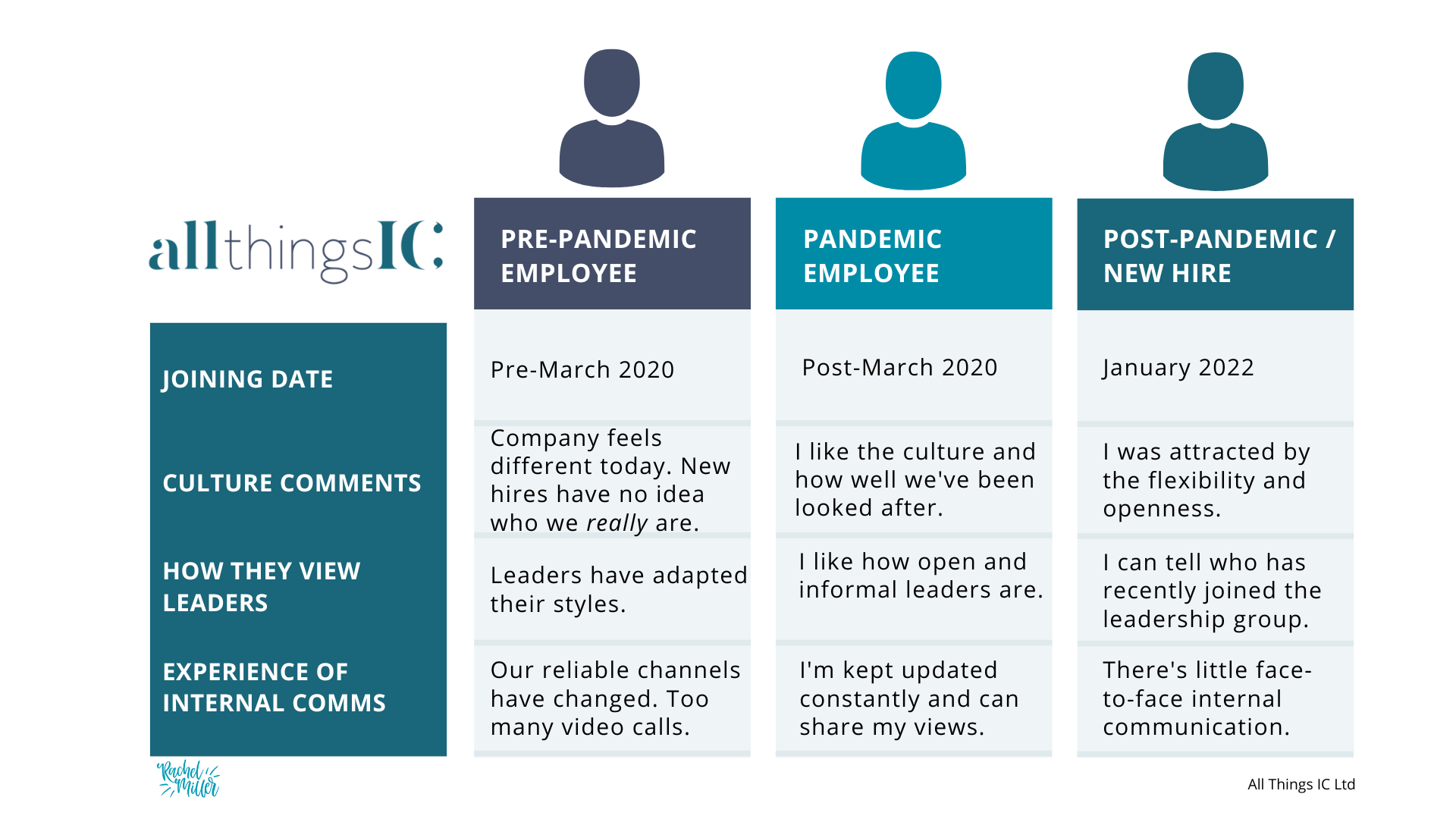Internal communication feels tough right now
Three distinct employee groups have emerged since the pandemic – and it's having an impact…
We’ve gone through so much as a profession in the past few years, not least communicating and advising our way through a global pandemic. As a result, I’m observing a shift in how we communicate inside organisations. Or more accurately, how employees experience internal communication and what their expectations are.
I am a believer in working out loud, I’ve been doing so since March 2009 via my blog and thought I would share my thinking. It’s not polished or perfect, but I hope you find my musings helpful.
I’ve been having these conversations with my 1-2-1 mentoring clients and Inner Circle members for just over a year. When we’ve been discussing how to plan internal communication or how to communicate change, it’s seemed tougher for professional communicators to make decisions.
I’ve found myself raising the topic of length of service as part of our conversations and querying whether we need to examine their plans through that lens. Why? I’m observing three types of employees in organisations nowadays. It’s not your usual frontline vs head office, or generationally or technology-access based, but length of service.
When I have raised this as a possible reason why internal communication planning feels tougher, it has sparked fresh thoughts and provided clarity for my clients.
I’ve classified them:
- Pre-pandemic employees – people who were in role pre-March 2020.
- Pandemic employees – people who joined organisations from March 2020 until January 2022
- Post-pandemic employees – people who joined organisations from January 2022 to date.
These dates feel variable. You may look at that list and think the first bullet point date needs to be January 2020 or even earlier, or perhaps the final one needs to be late 2021. It still feels too early to truly say post-pandemic, when so many countries around the globe are still experiencing Covid-19, but bear with me.
As internal communicators we know there’s rarely a one size fits all approach inside our organisations.
The impact of these three distinct employee groups is palpable. If I reflect on my own conversations with clients since the start of last year, it has shown up in a variety of ways and I’ve put it down to the three groups.
I’ve attempted to make sense of my thoughts against joining dates, cultural comments I’ve observed, how leaders are viewed and employees’ experience of internal comms.
I’ve presented the views as quotes below and have heard all of them during internal communication audits.

What would go into those boxes for your organisation? How are your leaders viewed when you map them against the length of service your people have? Does how long they’ve been in the company impact how trusted they are? What would you add down the left-hand side of the visual above? I encourage you to do that.
I’m sure you have a new notebook on the go, if you’re in planning mode for 2023, look at it through the lens of the employee groups listed, do you need to make any changes?
I wonder if any of these comments sound familiar to you:
“Our people enjoyed our virtual awards event so much they want us to do it virtually again this year.”
“We’re struggling to get new starters to want to come to the office.”
“Newer employees are confused about our channels. We paused some in the pandemic and they can’t figure out why they need to use them as they’ve never seen them before.”
“The IC team is now viewed tactically as we’ve had to be so reactive during the pandemic. How do we get back to being strategic advisers?”
“People who joined us in lockdown say they have proved their ability to work from home. They won’t come to the office.”
“We can’t recruit people to be in the office for more than 50% of the time.”
“Our frontline workers resent our head office workers. The divide is bigger than ever as they feel like they kept everything going in the pandemic.”
“The new starters need to be re-onboarded as they’ve never been in the office.”
“Leaders are pushing back against doing their own videos and want crews again.”
Do these resonate with you? I could make that list 10 times longer!
What does 2023 hold for your organisation? If you are making plans and decisions about what’s ahead of your people, leaders and organisation as a whole, bear these groups in mind.
What does this mean for internal communicators?
Stakeholder mapping has taken on a whole new meaning for me with my clients. I’ve found myself challenging assumptions, testing theories and trying to gather insights and evidence to help the internal communicators I have the pleasure of advising.
Listeners of my Candid Comms podcast will have heard me say I believe it’s our business to know our business as internal communicators. That means having active relationships across the organisation.
Look at your internal network. Do you know people across all three groups I’ve listed? The pre-pandemic employees, pandemic employees and post-pandemic / new hires.
How good are your relationships? Do you know what is top of mind for them? What is their experience and expectations when it comes to the way your organisation is communicating?
Look at your channels matrix. Think about it from the perspective of the employee groups. What’s their experience of internal communication? If they are new and don’t know the legacy of some of your older channels, but just know them in a revised (eg not face-to-face) format and do you need to update their purpose?
In closing, I encourage you to be kind to yourself. You may be finding internal communication tough right now because you are exhausted. So many internal communicators I know are experiencing burnout. The relentlessness of the past few years has caused a lot of stress and mental anguish. I encourage you to ask for help and seek professional advice to support and guide you.
No internal communicator is an island, myself included.
I’m continuing investing in counselling to support my own mental health. There’s no shame in it and in roles as visible as ours as internal communicators, it’s vital to make sure you look after yourself.
Rachel Miller is founder and principal consultant of internal communications specialists All Things IC.

